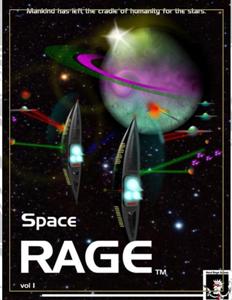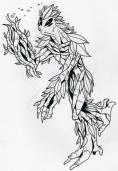
Product Name: Space Rage
Publisher: Nerd Rage Games
Author: Richard Green, Nicholas Huth, BJ Lewis, Zachariah Leonard
System: Rage Series
Setting: Space Rage
Series:
Theme: Military Sci-Fi
Type: Core
Link: http://www.nerdragegames.webs.com/
Space Rage is the first core product of a series of role-playing games using the Rage system (also known as the Rage Series of products). The Rage system is a modular game system allowing different settings, including genres, to be used as a plug-n-play situation to allow for customization of an individual adventure or campaign. Each core setting is designed to be compatible with other settings allowing the mixture of genres and a totally unique gaming experience. Space Rage introduces sci-fi into the system with a strong focus on military through space and planetary combat.
For mechanics, Rage is a roll-under system using a d20 and a target number based off a characters skills and attributes. For opposed encounters, the attacker compares their skill to the defenders’ skill and the difference becomes the target number. This means that with improvements to a characters attributes, skills, or equipment, rolling under that target number becomes increasingly easier (unless coming across an increasingly stronger foe). Space Rage brings about a wealth of near future sci-fi mechanics through a large listing of spacecraft and awesome weapons. However, the game-play mechanics are relatively simple to keep games moving without having to spend time referencing the rulebook.
CHARACTER CREATION

Character Creation starts with a look at the known races within the Space Rage setting. There are a total of 5 non-human races and all but one is meant to be a PC playable race. Each one is illustrated and fully described with a look at their background and their interactions with other races. While this may sound limiting, it’s actually a good start for a core rulebook and can easily be expanded upon with subsequent sourcebooks.
Character Creation quickly moves on to the actual character creation starting with attributes and calculating the appropriate target number modifiers. While the mechanics are good, the presentation is less than desirable. There are too many mechanics that are introduced in a single entry and could benefit greatly from being parsed out. This would mean each mechanic has its own rules entry with a description, purpose, and possibly example that expands on the very brief content that is currently presented. There is also a lack of consistency in presentation method which makes understanding a bit complicated at times.
However, by ensuring you are using the character sheet during character creation, the mechanics make more sense and the tables provide an easy way to properly fill-in that character sheet. The drawback to this is some may consider it as too many modifiers and some of them could be consolidated.
Once the character’s abilities and modifiers are figured out, character creation moves on to choosing an archetype and a category, where applicable. Each archetype and it’s category options carry specific skill options during character creation and help to better define who and what your character is. Once a characters skills are chosen, they move to the skills chart to calculate the skill value to finish up character creation.
CORE MECHANICS
The core mechanics are fairly simple as they work in the same fashion for each type of use. Skill checks are rolled against a character’s skill value (which becomes the target number) to perform the majority of the non-combat actions. Combat is performed using two ratings, and Attack Class (AC) and a Defense Class (DC). The simple use is take the characters calculated AC and subtract the targets DC, this results in the target number to roll equal to or below. Modifiers are based on a characters attributes, equipment, cover, and level.
A couple interesting combat mechanics are “Hit-Location” (which could be referred to as how well you hit the target) and Critical Hit. Each weapon has a damage rating and the Hit-Location determines the percentage of that damage rating that causes actual damage. Critical Hit is a cinematic addition to combat that allows for special effects that occur when rolling a critical for the Hit-Location roll.
Within the Core Mechanics sections are the full listings of the skills and how they are calculated. The list of skills is quite large, similar to some d100 systems. I question the need for some of them as they seem a little redundant. However, each skill is fully described and are easy to understand.
Finishing up the Core Mechanics are rules for followers. This is where you build an army and take that military force head-to-head with the enemy! There isn’t a lot for core mechanics, keeping the system relatively rules light. This can offer more flexibility and move players to use their imagination more than worrying about what the rulebook says.
EQUIPMENT
There isn’t much that needs to be said about equipment. The list of essential equipment is fairly standard with other sci-fi systems and the weapons listing coincide with the military feel of Space Rage. However, there is a list of Ground Artillery weapons, something not typically found. These are the big guns that you can use to keep your planet safe from alien invasion.
SPACECRAFT, AIRCRAFT, & ARMORED VEHICLES

These are the sections that make Space Rage truly shine! As opposed to simply stating spacecraft that may have weapons or may just carry cargo or may just be for diplomatic reasons, Space Rage takes this to a much higher level. As with some sci-fi space combat films, Space Rage brings a space naval fleet and places it within the mechanics and setting. This means you have interstellar vessels, capital ships, dropships, star fighters, and everything you need for planetary combat. This list is HUGE!
Without getting into too much detail, there are almost 40 different spacecraft detailed along with tools on how to create your own. Each spacecraft is fully described and all applicable attributes are included. Along with this are the associated mechanics including speed, maneuvering, weapons, crew, hull, cost, mass, and availability. All of this adds up to exciting space combats with very detailed spacecraft. The only thing missing are illustrations and possibly mapped layouts. But this doesn’t even cover the extra mechanics that are offered to help flesh out the details of the spacecraft including propulsion system, thruster speed, and the optional ship sections. The spacecraft section is so comprehensive that you could almost take this and place it into any system where a spacecraft is needed.
But space combat isn’t the only option, planetary combat is covered as well. While not as comprehensive, there are listings for aircraft, ground vehicles, robots, and ground artillery. Each one is, again, fully detailed and includes all applicable attributes.
SETTING
The base setting for Space Rage is within our galaxy and expanding from there as a number of FTL “jumps” to go from planet to planet. There are a number of colony worlds presented with a fair amount of detail and description, but not to the point where it ties the hands of the GM. The setting is very flexible and open to a “world” of possibilities. It could be said that the presented setting is more of a framework and the details are left to the Gamemaster.
OVERALL
Overall I think the Rage system is a solid, rules-light system that could provide relatively easy play. You could make the argument that there are too many attribute modifiers, but at least each one has a purpose and should come into play often. Space Rage is a great start to the system and I’m very interested in seeing some of the subsequent releases.
RATINGS
Publication Quality: 5 out of 10
The Character Creation sections could benefit greatly from a revision to layout, presentation, and description. The publication could also benefit from better defined sections with either an index or a more comprehensive table of contents for quicker referencing. But the remaining sections are smooth and concise making reading much and comprehension much easier. There are many illustrations, although small, that help to enhance the visual appeal of what is being presented. However, with a rules light system, character creation becomes very important and you don’t want players to get confused when working through the mechanics.
Mechanics: 9 out of 10
I like the single d20 roll-under system with a target number based off your own characters skills and abilities. This allows for a character to improve through play by increasing the target number and thus making it easier to succeed. The mechanics for spacecraft, aircraft, and vehicles is extremely concise and filled with options that you may not usually consider. Nerd Rage Games has considered many things when presenting a believable spacecraft or other vehicle with many options for customization and cinematic effect.
Desire to Play: 8 out of 10
Space Rage contains a well-developed combat system for space and planetary combat. While many systems focus upon the small picture of the individual characters, Space Rage opens up the window to a grand scheme allowing for large-scale encounters. If you are looking for a system with the ability to recreate truly cinematic interstellar combat, then Space Rage may be what you’re looking for.
Overall: 7 out of 10
For a military sci-fi system, Space Rage has lots of options to keep players on their toes. But for those looking for more than just combat, there are options for space travel and interaction between different alien races. The “look and feel” of the system is very similar to many of the sci-fi space combats seen in movies or read in fictional publications. And with the option to add other Rage modules, game-play could vary greatly from campaign to campaign.
